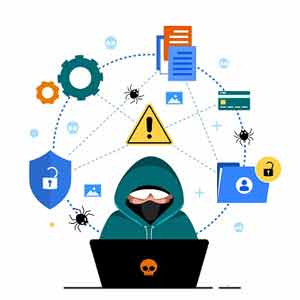IoT devises Vulnerability Assessment
The IoT is a system of physical devices, vehicles, home appliances and other items that are embedded with electronics, software, sensors, actuators and connectivity which enable these objects to connect and exchange data. The term “Internet of Things” was first coined by Kevin Ashton in 1999. we are providing Iot Devices Vulnerability Assessment to protect them from the latest cyber threats.

What is IoT Devices Vulnerability Assessment
As the internet of things (IoT) continues to grow, so do the opportunities for attackers to exploit vulnerabilities in these devices. IoT devices are often used in mission-critical applications and can be difficult to patch or update, making them a tempting target for criminals.
IoT Device vulnerability assessment is the process of identifying, assessing, and mitigating vulnerabilities in IoT devices. By understanding the risks associated with these devices, organizations can take steps to protect themselves from attacks.
There are a number of factors to consider when conducting an assessment, including the type of device, its purpose, and how it is interconnected with other systems. Additionally, it is important to understand the potential consequences of an attack on these devices. For example, a breach of an IoT device used in a healthcare setting could have serious implications for patient safety.
Once vulnerabilities have been identified, organizations can take steps to mitigate them. This may include implementing security controls such as encryption or authentication or changing the way the devices are used or configured. In some cases, removing IoT devices from service may be necessary if they cannot be adequately protected.
By taking these steps, organizations can help protect themselves from attacks on their IoT devices.
IoT Device Security Issues
There are a number of potential security issues that can arise with IoT devices. Here are some things to consider when assessing the security of your IoT devices:
Insecure or Outdated Components
IoT devices offer numerous avenues for improving processes and boosting efficiency in industries, hospitals, homes, cars and cities. However, they also introduce new attack surfaces for cyber criminals to exploit. As a result, the number of IoT cyberattacks has been increasing at an alarming rate.
Fortunately, vulnerabilities can be identified and quantified with state-of-the-art IoT vulnerability assessment tools such as Shodan (Internet-connected device search engine) and Kitchenham et al. [64]. These frameworks use a base metrics group and vulnerability scores to identify IoT devices and assess their security levels.
Insecure or outdated components and third-party software used by IoT devices can create a number of threats. For example, if communication to web and backend APIs is not encrypted or input/output data is not filtered correctly, it can be easy for adversaries to hack the device and compromise an entire network. It is important to use secure update mechanisms such as OTA to avoid these risks. These updates should be validated, securely delivered and include anti-rollback mechanisms to prevent the downgrading of firmware. IoT devices should also provide a prominent indicator and simple procedure for applying OTA updates.
Insufficient Authentication Hygiene
Default or hardcoded passwords make IoT devices easy targets for attackers to breach. Once a device is compromised, it can become the gateway into your business’s network and provide unauthorized access to sensitive information.
Insecure communication protocols allow data to be sent between IoT devices and back-end systems, potentially opening up sensitive information to interception and tampering. Lack of encryption can also expose data to malicious exploitation, whether in storage or transit, as well as create operational disruptions or raise financial liability.
Lack of secure updates presents a significant vulnerability that attackers can use to install unauthorized firmware or software and expand an organization’s attack surface. This can be achieved through insecure channels, unpatched vulnerabilities, anti-rollback safeguards that fail to protect against rogue changes, and the absence of a secure boot mechanism.
IoT / IIoT manufacturers often fail to release security updates in a timely manner, leaving devices open to exploitation from known vulnerabilities. By regularly monitoring public-disclosed vulnerabilities and updating devices throughout their lifecycles, you can protect your IoT / IIoT assets from attack.
Insecure Network Connections
Many IoT devices use unsecure connections to traditional network endpoints, which allows hackers to eavesdrop on the data they send to or receive from the device. This could allow them to steal login credentials, reroute sensitive information, or launch attacks like Man-In-The-Middle (MITM), botnets, and Distributed Denial of Service (DDoS) attacks.
Furthermore, IoT devices often fail to secure their boot process and lack anti-rollback safeguards that prevent unauthorized software or firmware updates. This is a significant vulnerability area, since unauthorized updates allow attackers to gain control over the device and execute malicious payloads or commands.
Attackers exploit vulnerabilities in the connection protocols used by IoT devices to spoof their identities and access private information, enabling them to evade detection and take other illicit actions [10]. They also commonly use default or hardcoded login credentials to access the device operating system and connect to the internet. As a result, a significant number of IoT devices are exploited as part of large-scale botnets or cyberattacks [13].
Weak or Default Credentials
The use of default passwords and lax password management practices allow adversaries to gain access to the device. These attackers can then launch distributed denial-of-service attacks or download malware. In addition, the IoT devices can also be used as bots to attack other systems.
Adversaries can easily locate Internet-connected OT and SCADA devices by scanning networks using tools like Shodan. The resulting information allows adversaries to determine the vulnerability of these devices, and even exploit their web systems.
How to Secure IoT Devices?
The internet of things (IoT) is rapidly becoming a part of our everyday lives, with devices such as smart TVs, thermostats, and even doorbells connected to the internet. However, as convenient as these devices may be, they also come with security risks. IoT devices are often targets for hackers due to their lack of security features, making them easy to exploit.
One way to help secure IoT devices is to perform a vulnerability assessment. This can involve using a tool like Nmap to scan the device for open ports and known vulnerabilities. Once you have a list of potential security risks, you can then take steps to mitigate them. For example, you might need to update the firmware on the device or change the default password.
By taking some time to assess the security risks of your IoT devices, you can help protect yourself from potential attacks.
IoT Device Vulnerability Assessment Tools
When it comes to the vulnerability of IoT devices, there are several assessment tools available to help organizations understand where their devices may be at risk. Here are a few of the most popular IoT vulnerability assessment tools:
- Rapid7’s Metasploit Framework: This open-source framework can be used to test for vulnerabilities in IoT devices and systems. It includes a wide range of features and is constantly being updated with new exploit modules.
- Qualys’ IoT Security Scanner: This scanner provides comprehensive assessments of IoT devices and systems, looking for both common and uncommon vulnerabilities. It offers a simple interface and can be easily integrated into existing security workflows.
- IOActive’s IOAsysmon: This tool is designed specifically for assessing the security of embedded systems and IoT devices. It includes a wide range of features, including the ability to fuzz test for vulnerabilities.
- Forescout’s CounterACT: This solution offers comprehensive visibility into all devices on a network, including IoT devices. It includes a range of features for assessing and managing device security, including the ability to block or quarantine devices that pose a risk.
- Cisco’s Talos Intelligence Group: This team is one of the largest commercial threat intelligence teams in the world.
Conclusion
IoT devices are becoming increasingly popular, but they also come with a number of security risks. It’s important to perform a vulnerability assessment on any IoT device before using it, in order to identify and mitigate any potential risks. By following the tips in this article, you can ensure that your IoT devices are secure and safe to use.
Other Cyber Security Services
| Cyber forensics & cyber security legal service | Cyber security products and services |
| Cyber information security consulting services | Cyber security professional services |
| Cyber risk management for managed security service | Cyber security professional services website |
| Cyber security & risk services crs | Cyber security quality assurance services |
| Cyber security advisory services | Cyber security regulations financial services |
| Cyber security advisory services | Cyber security resilience services |
| Cyber security analytics services | Cyber security response services |
| Cyber security and ai service providers | Cyber security risk & services |
| Cyber security and grc services | Cyber security risk and compliance service |
| Cyber security and it services | Cyber security risk management services |
| Cyber security and protection of digital services | Cyber security service bases companies |
| Cyber security and risk services | Cyber security service level agreement |
| Cyber security as a service | Cyber security services |
| Cyber security as as service | Cyber security services and trainings |
| Cyber security assessment services | Cyber security services cloud |
| Cyber security assessment services tech support | Managed cyber security services |
| Cyber security audit services | Cyber security services for individuals |
| Cyber security banking and services | Cyber security services for small business |
| Cyber security breaches financial services | Cyber security services public transit |
| Cyber security cloud services | Cyber security solutions and services |
| Cyber security companies services | Cyber security testing service |
| Cyber security consulting services | Civil service cyber security |
| Cyber security detection services | Cyber security training services |
| Cyber security experts service | Cyber security transformation services |
| Cyber security for managed security service provider | Managed cyber security services for small business |
| Cyber security framework for financial services | Cyber training and information security services |
| Cyber security in asset management services | Managed cyber security services |
| Cyber security incident response services | Denial of service attack cyber security |
| Cyber security issues with outsourcing it services | Denial-of-service attack cyber security |
| Cyber security managed security services | End to end cyber security services |


